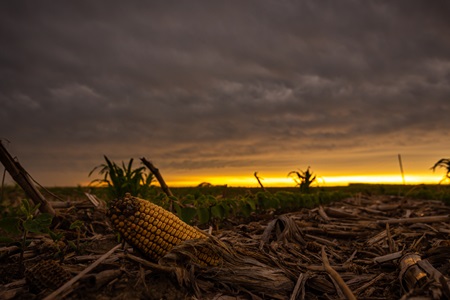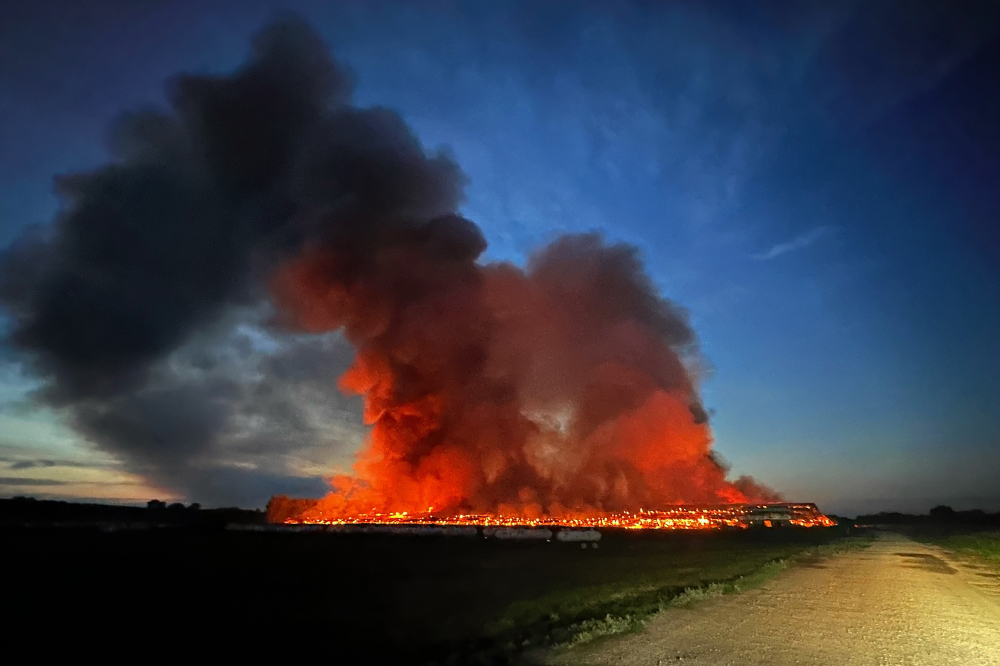CLICK HERE for the latest market quotes from the Iowa Agribusiness Network!
CLICK HERE for the latest market quotes from the Brownfield Ag News Network!
CLICK HERE for the latest market quotes from the Iowa Agribusiness Network!
CLICK HERE for the latest market quotes from the Brownfield Ag News Network!
(Radio Iowa) – After feuding for decades, the leader of the American Petroleum Institute says the oil and gas industry has a shared mission with biofuels producers. Mike Sommers is president and C-E-O of the American Petroleum Institute.
“There’s kind of been this longstanding ‘cold war’ between ethanol and corn and oil and gas, but at this point I think we have two industries that are uniting,” Sommers says, “united to fight for liquid fuels in this country.” Regulations that promote the sale and use of electric vehicles are now the common foe. And the American Petroleum Institute has ended its opposition to nationwide, year round sales of gasoline with a higher blend of ethanol.
“We recognize the growing role for E15 in the marketplace and ensuring American consumers have access to the fuels that they depend on every single day,” Sommers says. The petroleum industry supports carbon capture technology and liquid carbon storage underground. Sommers says more pipeline infrastructure is needed.
“I think every American agrees that we should be reducing emissions not just in the oil and gas industry, but in all manufacturing.” Backers of the proposed Summit Carbon Solutions project in Iowa say it will make ethanol a low-carbon or carbon-free fuel — spurring sales in places in California. Sommers says federal tax credits for carbon pilelines should be retained, while eminent domain authority to seize land from unwilling property owners should be the last resort for pipeline developers.
“Our first priority is engaging property owners at the beginning of the process so they understand the importance of developing these pipelines,” he says, “and that they see financial benefit from it.” Sommers hopes to visit Iowa during the State Fair. He was unable to make it to in-person meetings in Iowa yesterday (Tuesday) due to airline delays and cancellations.
Iowa State University Extension and Outreach and the United States Department of Agriculture’s Natural Resources Conservation Service are collaborating on a series of cover crop fact sheets for Iowa farmers interested in adopting the practice or trying new cover crops to achieve specific goals on their operation.
Thousands of Iowa farmers plant cover crops annually to help reduce soil erosion, increase soil organic matter, suppress weeds, minimize soil compaction, scavenge excess nutrients or provide supplemental livestock grazing. A large percentage of Iowa farmers use cereal rye, oats, wheat, radishes and turnips. However, there are many other cover crop options available.
The collection of fact sheets includes legumes like hairy vetch and cowpeas, broadleaves like flax and buckwheat, grasses such as millets and triticale, and brassicas like camelina and rapeseed.
“We feel these fact sheets are a good introduction to cover crops for producers who haven’t tried them yet,” said Mark Licht, associate professor and cropping systems specialist with ISU Extension and Outreach. “There are also species that a more seasoned cover crop user might be interested in learning more about.”
More than 25 fact sheets are currently available on the Iowa NRCS website, with 33 fact sheets expected by the end of August and the potential to add additional species as interest develops. Each fact sheet includes sections on identifying features, cultural traits, planting information and performance ratings, and pictures that highlight various features and growth patterns.
“The collaboration between ISU Extension and Outreach and NRCS on the fact sheets is important,” said Iowa NRCS state soil health specialist Hillary Olson. “We are on the same page in the belief that all Iowa crop producers can find a way to make cover crops work on their farms. We feel these fact sheets will be a valuable learning tool for producers.”
(From ISU Extension)
DES MOINES— Governor Kim Reynolds, together with Iowa’s entire congressional delegation, today sent a letter to U.S. Department of Agriculture (USDA) Secretary Tom Vilsack, urging him and the department to “utilize their existing statutory authorities to adjust their disaster programs to provide farmers, ranchers, and producers with the flexibility they need after a natural disaster to recover and rebuild.”
The letter comes after the state has endured three natural disasters in as many months, including two destructive tornado events and devastating floods in northwest Iowa, severely impacting rural areas and numerous farms.
The letter highlights the differences in flexibility between programs provided by the USDA and those offered by the federal Small Business Administration (SBA). Particularly, it calls out the USDA’s programs for not providing assistance for farmers commensurate with the SBA’s programs for small businesses.
The letter reads in part:
“The Small Business Administration’s (SBA) disaster assistance programs offer vital, flexible support in difficult times to small businesses. We understand that these programs are limited to non-agricultural small businesses, with USDA providing access to complementary programs, such as the Emergency Loan Program, that are intended and specifically designed to assist agricultural producers like farmers and ranchers. While USDA and SBA coordinate to ensure these programs effectively reach rural small businesses, we continue to hear from disaster victims that the terms available to borrowers within the USDA programs are less favorable compared to those at SBA, which offer a greater amount of flexibility with interest, balance, and payment terms. Similar to our request today, the SBA provided much of this flexibility in 2022 and 2023 by utilizing administrative authorities.
“As Iowans begin to recover from the many disasters that have impacted them, the historical and continued lack of fairness in what rural communities are offered by USDA is having a meaningful and substantial impact. Consideration should be given to these communities, which are integral to feeding America and the world, by granting them the same or similar terms through USDA as those that are provided to less rural areas through SBA. USDA can do this through its existing statutory authorities, which provide it with the ability to make all loans repayable at such times as the Secretary may determine, and broad authority to set interest rates at a level prescribed by the Secretary, but not in excess of 8 percent per annum. We encourage you to utilize these existing authorities to defer payment on disaster loans for a full year and reduce interest rates to zero during that deferment. This would provide much-needed parity to farmers as they rebuild their agricultural operations.”
The letter is signed by Governor Reynolds along with Senators Chuck Grassley and Joni Ernst, Congressmen Randy Feenstra and Zach Nunn, and Congresswomen Ashley Hinson and Mariannette Miller-Meeks.
The letter can be read in its entirety on the governor’s website.
(Radio Iowa) – The Iowa Department of Natural Resources is investigating a large fish kill in northeast Iowa. The D-N-R says the fish kill was first identified in Crane Creek in Bremer County near the town of Readlyn. A news release says the creek has been significantly impacted, with dead fish being seen nearly 20 miles downstream, near Dunkerton in Black Hawk County.
The D-N-R gives an intersection near Readlyn where the problem may have originated but did not identify the source.
(Radio Iowa) – Many parks, trails, waterways and docks in northeast Iowa are reopening as early summer floodwaters recede, but safety for parkgoers remains a concern as bacteria and other contaminant levels in area rivers remain high. Lori Eberhard, park director for George Wyth State Park in Black Hawk County, says even though the rivers might look safer with the water levels down, the risk of illness for swimmers remains high.
“If our bacteria level’s high at the beach, I would still swim there before I would swim in the river after flooding,” Eberhard says, “especially when you have major flooding, it gets into those different systems all the way down the river, and that’s what’s in the water.” The Iowa D-N-R tests bodies of water weekly to track those levels, but contaminants are still elevated due to stagnation and sediment that comes with flooding. When hiking, Eberhard stresses caution even when the ground appears stable.

file photo
“There are low spots that still have water on them,” she says. “We don’t recommend going through flooded trails or water, because you don’t know what’s under there, you don’t know if there’s a hole or things like that. And now, with all the water along the trails, trees will just fall down.”
The D-N-R says around a dozen beaches at Iowa lakes are not recommended for swimming this week due to high levels of e-coli, algae toxins, or both.
(Radio Iowa) – Researchers recently discovered what’s known as a “remnant prairie” at the Iowa State University Horticulture Research Station and they’re working to restore it. Remnant prairies have never been plowed or completely converted into non-native species. Only about zero-point-one percent of this original habitat remains in Iowa, though it once covered nearly 80-percent of the state. Nick Howell is superintendent for the horticulture research station. “This was found as a fluke,” Howell says. “When I started here in 2006, you couldn’t even get to it. It was just completely full of scrub brush.”
He says the one-and-a-half acre area beside a lake was totally overgrown, but three years ago, a researcher recognized seeds pods under snow while working on a fish habitat project. Howell says prairie specialists came out that spring to confirm it was a remnant. “It had been protected for a long, long time,” Howell says, “and once we cleared the brush and started burning it, the prairie species started to re-appear.” Prairie intern Rachel Sents says it’s taken a significant amount of work to get the prairie back into its original shape. “Really what we’re doing out here is we’re trying to fight back on those species that are out-competing with the natives,” Sents says, “and give the natives a better chance.”

Monarchs flourish on native Iowa milkweed plants — Photo by Karl Schilling
I-S-U ecology professor Brian Wilsey says the remnant prairie at the research station north of Ames is a true gem, filled with all sorts of native plants. “This is a wild bergamot and then of course, there’s rural milkweed, one of the hosts for our monarch butterflies,” Wilsey says. “Most prairies that you visit are reconstructions, so they’re seeded prairies on old crop fields like at Neal Smith and other places. The remnants are really rare.”
Reconstructed prairies are becoming more common, Wilsey says, and they currently account for one-to-two-percent of the state.
(by Rachel Cramer, Iowa Public Radio)
(Iowa News Service) – Farmers in Iowa are studying interactions between crops, water usage, carbon and nitrogen storage, and how those factors combine to affect longterm soil biodiversity. It’s part of a seven-state project in the Midwest. Researchers are looking at the effects of crop combinations on soil and moisture across the Corn Belt.
Iowa State University Agronomy Professor Sotirious Archontoulis is running one research site in the five-year, $16 million project. He’s monitoring how crop management, carbon and nitrogen content affect soil moisture – and will try to predict the impact on the viability of future crops. “We have the same setup in many different environments to capture different organic matter, soil hydrology conditions,” said Archontoulis, “so we get a better understanding of the complexities in the agronomic system.”
Archontoulis said scientists can also study greenhouse gas emissions from the soil. He said these ultimately affect its health and can have an impact on large ag operation waste runoff, which is known to pollute nearby ground and surface water. The research is gearing up now. 
Based on the computer model’s findings, Archontoulis said researchers can make recommendations to farmers based on – for example – how much nitrogen the soil is losing in certain places, and how they can adjust planting schedules as a result.
“We can say, ‘This cropping system with this management practice typically loses that amount of nitrogen,'” said Archontoulis. “‘However, the other combination of cropping system could reduce nitrogen loss and improve productivity by X%, so this is a better strategy to move forward.'”
Archontoulis said the research begins across the Midwest this summer.
(Atlantic, Iowa) – The City of Atlantic’s Parks Advisory Commission are set to hold their regular monthly meeting on Wednesday, beginning at 3:30-p.m. The meeting takes place in the Parks and Rec Office located just off Sunnyside Lane (1200 Sunnyside Lane).
Old business for the Commission includes updates on:
Under New Business, the Parks Commission will discuss costs associated with a swing set at Harl Holt Park, and foam safety (Fall) padding for the swing set base.
(Des Moines, Iowa) – The Iowa Department of Natural Resources has ordered three people to pay $10,000 apiece for burning 10 chicken confinement buildings near Villisca last year, without proper approval. Shawn Gohlinghorst of Red Oak and Darrel Schipansky of Villisca were recently fined for the June 29, 2023, fires. The DNR had previously fined Tyson Means of Villisca.
The Iowa Capital Dispatch previously reported the men had sought to raze the dilapidated buildings and grow crops on the land. Schipansky owned the property at the time of the fires, and Gohlinghorst and Means later bought it on contract.
Although state law typically forbids people from burning buildings to dispose of them — because of the potential to diminish air quality — there are exceptions for agricultural buildings. However, the men failed to inspect the buildings for asbestos, and they did not get approval from the local fire chief, which was required because the buildings were within city limits.
Each of the wood-framed buildings was 50 feet wide and 728 feet long, the DNR orders said. They were ignited about 3 p.m., after recent rainfall. Emergency responders were not aware of the fires before nearby residents began calling about them. “Various governmental entities in Montgomery, Page and Adams counties received dozens of telephone calls regarding the fire and black smoke,” the DNR orders said.

Fires burned 10 former chicken confinement buildings near Villisca in June 2023. (Photo by Brian Hamman/courtesy of Iowa DNR)
Brian Hamman, emergency management coordinator for Montgomery County, said the fires burned into the night, and that their smoke and glow were visible for miles. They were so large that it would have taken nearly 10 area fire departments to extinguish them if they began to spread, the orders said, but they remained confined to the building sites.
Sampling of the building debris did not reveal any asbestos, but it was not possible to determine whether asbestos existed in the building before the fires, the orders said. Gohlinghorst and Means disposed of the remaining debris at a landfill in September and October 2023.
All three men agreed to pay the $10,000 fines, which is the highest amount the DNR can assess administratively.
(Iowa Capital Dispatch) – All parts of Iowa — for the first time in more than four years — have sufficient soil moisture to not be considered “abnormally dry” by national climate experts, according to a U.S. Drought Monitor report on Thursday. That dryness designation can indicate an area is on the cusp of drought conditions, under which affected areas can have negative impacts for agriculture and water supplies.
An example: After years of drought, a lake that supplies water for the city of Osceola had lost so much of its volume that the city considered recycling its wastewater. Significant rainfall in recent months has restored the lake to nearly its normal surface elevation, according to city data.
Drought developed in Iowa in July 2020 and persisted until May 2024, after the state had one of its wettest starts to a year on record. It marked a dramatic recovery since September, when the state was the driest it had been in a decade. Last week, Iowa had rainfall that was below average, according to State Climatologist Justin Glisan. However, heavy rain fell along the eastern edge of the state where the last remaining pocket of abnormal dryness lay.
A month ago, about 31% of the state was abnormally dry, according to Drought Monitor reports. The last time there was no drought or dryness was May 2020. The federal Climate Prediction Center does not foresee drought reemerging in Iowa in the coming months. Iowa lies in the center of a multistate area that has no drought and little abnormal dryness.
The U.S. Department of Agriculture reported this week that more than 90% of Iowa’s farm fields have adequate or surplus moisture for growing crops. Last year, only 57% of topsoil was rated the same way.